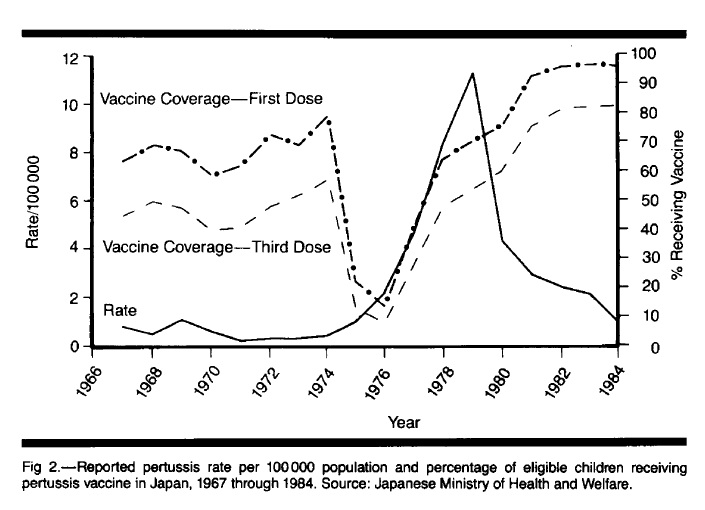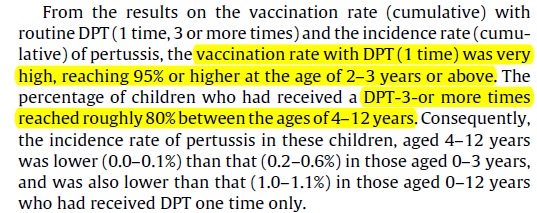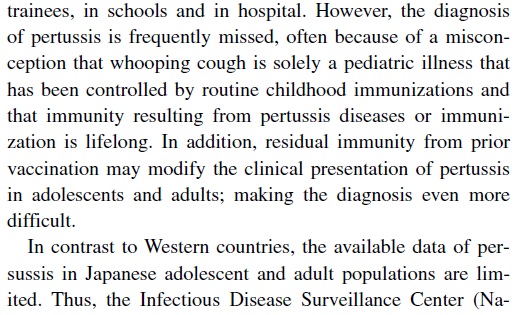It will be easier to understand this blog if you read all the material embedded. In a letter dated 18 May 2012, the Ministry of Health wrote:
The pertussis containing vaccines are effective but do not protect all babies. The pertussis vaccine currently used in New Zealand and other developed countries offers protection of around 84 percent after three doses….. Adults immunisation is recommended for those who have contact with babies or someone who has an underlying respiratory condition.
Pertussis incidence and mortality have declined in the last 50 years in many places around the world mainly as a result of immunisation activities. However, the incidence of pertussis disease has increased in countries where pertussis immunisation rates decreased in the past for example Japan, Sweden and United Kingdom. When immunisation programmes were re-established the rates of disease decreased again.
So lets look at the comment about Japan, because again, the insinuation is that before Japan dropped the vaccine in 1974, things were great, and after they started the vaccine, things went back to 'wonderful'.
The classic article quoted by vaccine pushers, relating to the rise of pertussis notifications after the discontinuation of pertussis vaccination in Japan is: "Impact of antivaccine movements on pertussis control: the untold story" written by E. J. Gangarosa et al. Lancet, volume 351, January 31, 1998.
As I stated in a 2005 BMJ rapid response there are many problems with this article, but let's just stick with Japan for the purposes of this blog.
As the reference for 80% vaccination rates in Japan in 1974, Gangarosa quotes a Lancet study,("Developments in pertussis immunisation in Japan", by Kimura M et al) July 1990; 336: 30 - 32 article .
But, that referenced study ... didn't mention vaccination rates.
 Gangarosa made a big deal of the vaccine uptake dropping from 80% - 10% in 1976. Gangarosa implied that those vaccination levels prior to parents stopping it, was “good protection". See that 80%?
Gangarosa made a big deal of the vaccine uptake dropping from 80% - 10% in 1976. Gangarosa implied that those vaccination levels prior to parents stopping it, was “good protection". See that 80%?
.... One shot only.....
The total for THREE primary shots of pertussis vaccine was 56% in 1974 down to 9% in 1976.
But a "three shot" vaccination acceptance at 56% to 9% .....couldn’t possibly be used to claim good protection could it?
So Gangarosa chose to use the 80% to 10% drop, but NOT TELL THE READERS that it was only for one shot.
An 80% coverage of only one shot isn't even worth writing to granny about.
So, Gangarosa couldn’t quote the right reference, and didn’t mention that the 80% was one shot only.
Perhaps he didn’t think anyone would bother to check his data. After all, Gangarosa is “a good guy” and wouldn’t possibly get facts wrong.
Perhaps Gangarosa didn’t care, since his mission was to pillory those of us who don’t vaccinate – and who of his mates would suspect him of misusing data, and providing a crock reference to “prove” it? (The rest of his article is blighted with similarly license…)
FACT: Those figures are no basis upon which to make an argument that "anti- vaccinators" ruined it all for Japanese babies.
FACT: I wrote a full rebuttal to this article and submitted it to the Lancet, who refused to publish it. (No surprises there)
So exactly what were the facts before the vaccine was dropped in 1974?
The same as the "facts" for case notifications in Britain (See Immunity) a medical profession incapable of accurately diagnosing and reporting whooping cough.
Before 1974, Japanese doctors were not reporting the majority of whooping cough because, "there was a vaccine" and whooping cough wasn't seen as a huge problem.Like Great Britain, they didn't know the Japanese whole cell vaccine was as bad as everyone else's but they didn't like the side effects they were seeing.
ONLY after the vaccine was discontinued, did notifications rise, because in 1976, the Japanese Ministry of Health (as did the UK Ministry of Health) instructed all doctors to be on the look out for, and test every cough no matter what sort - for pertussis, and reporting was made "compulsory".
Japanese vaccination uptake in 1974, was even more pathetic than in New Zealand. While pertussis vaccination had been "made compulsory" very early on, and is still "compulsory" --- in reality the word "compulsory" doesn't mean that much in Japan. I have many friends in Japan, and if you mention the word "compulsory" they smile, raise their eyebrows and change the subject.
One thing we do know from the UK data, and NZ data ... is that inevitably, when the medical profession finally pulls finger and looks for whooping cough, their notifications sky rocket. Suddenly, a disease which has always been there, but they didn't (couldn't?) see, or misdiagnosed as "something else", becomes a whooping cough "epidemic".
Even today in Sweden, which has the most comprehensive diagnostic and notification system, only one in 1,000 infections are reported (Hallander 2012). If that's the case when doctors supposedly have got their act together, what was it really like in the days of laisse faire when doctors just assumed their "magic vaccine" worked?
Just as In Sweden and the UK, the "rise" in pertussis was MORE because of the lack of diagnoses and notifications, rather than either underimmunisation, or stopping a vaccine. After all, for decades, the UK vaccine had been about 20% effective, .... Sweden's vaccine was ZERO, .... and Japan was the first country to develop an acellular vaccine because of lousy vaccine efficacy AND high rates of reactions.
While more recent Japanese medical articles, like Swedish articles, again proclaim the new acellular vaccine to be better than sliced bread - resulting in a cataclysmic slide in cases, .... is that really the case? A recent article (Baba 2011) on vaccination rates in Japan, was based on a questionnaire (you'd think they would have a vaccine register, but no.... ). If the following is extrapolated out for the whole of Japan, then I would think Nikki Turner would have conniptions, because FAR from an effective level of vaccination, this level is... immunologically insane, so the question has to be asked, "Why is pertussis infection seemingly low in Japan?"

No-one can claim that pre-1974 vaccination rates for whooping cough in Japan, UK or Sweden, could have had any impact on the pattern of infection there.... and there isn't too much complimentary to say about the vaccination rates described above. It could well be that "fact"that in Japan, Ground Zero data doesn't match the New Zealand Ministry of Health's rhetoric inferences.
a 1988 abstract reads:
In 1975, with two successive cases of death shortly after whole cell pertussis vaccine, administration of pertussis vaccine was temporarily suspended. The vaccine was soon resumed, but setting the vaccination age at over two years for group vaccination. This caused the fall in pertussis vaccine acceptance rates until 1980, resulting in a nationwide epidemic of pertussis infection, with the peak of the epidemic in 1979. Acellular pertussis vaccine was developed and introduced in 1981, since then the coverage rate with the three-time pertussis vaccination have retained the levels of more than 80%. The number of cases of pertussis infection decreased steadily since 1980 and in 1985, the number of total pertussis patients was as low as those observed before 1974. However, incidence of pertussis patients aged less than 2 year remained higher. Dramatical decrease in side effects of pertussis vaccination was observed after the elevation of the age of the vaccination at mass immunization clinic to two years. Side effects has decreased further after the introduction of acellular pertussis vaccine.
But every now and again, such as this 1995 article, you get a fleeting glimpse that all is not as the New Zealand Ministry of health says:
Abstract: An outbreak of pertussis was recognized in a highly immunized sixth-grade class of schoolchildren. Among 43 children aged 11-12 years in the class, 38 had been immunized with three doses or more of DTP containing whole-cell pertussis vaccine, two with two doses of DTP and three children were unimmunized. The last DTP vaccines had been given 6-10 years before the outbreak. A total of eight children with pertussis suffering paroxysmal coughing attacks for 3 weeks or more were identified, seven being fully immunized and one unimmunized. Among the eight cases, two were confirmed by both culture and serology and one by serology alone. The attack rate in fully immunized children was 18.4% (7/38). Secondary spread of pertussis was identified in five of the households from which the eight patients originated. A total of six cases of pertussis from these five households were identified, and two of these were culture-confirmed. These observations suggest that vaccine-induced immunity weakens considerably 6-10 years after vaccination, and that booster immunization with DTP instead of DT is therefore recommended for the control of pertussis.Yet, no booster was added, and I can find no reason why. Furthermore, Miyashita 2011 admitted that diagnoses are missed and that "data is limited". (Perhaps that's why they do parent surveys!)
The first interesting thing about this article is the description of normal medical practice, whereby they don't bother to definitively diagnose WHAT causes coughs. After all, there are several bacterial and viral organisms which are NOT Bordetella Pertussis which also cause an identical symptomatic picture:

So ... why is the diagnosis frequently missed?... Because of the assumption that whooping cough only happens in babies, and immunity will last through life, so no doctor should see whooping cough in an older patient.

And their study also showed that there was a high rate of carriage of whooping cough bacteria, amongst the asymptomatic, who the doctors assume are "immune":

Amazing what you actually find, when you... decide to look!
If lack of definitive diagnoses andwidespread whooping cough carriage applying right across Japan was confirmed and studied, you wonder what the vaccine efficacy rates would then tumble to!
Japan is held up as a paragon of virtue. Yet, if New Zealand, like Japan, only had an 80% acceptance rate for three shots by age of six YEARS...., IMAC would be getting out the public flaggelation whip, screaming about the lack of timely vaccination, and adding at least two more boosters to the schedule - because .... the Japanese vaccination rates for pertussis are way worse than the pertussis vaccination rates in New Zealands, despite Japan's "compulsory" status.
Therefore the New Zealand Ministry of Health is incorrect in their implication that the dropping of the vaccine in Japan in 1974 resulted in a rise in the cases there, - implying that the vaccine had "worked" before 1974, and that their wonderful vaccination coverage is now something for New Zealand to emulate.



